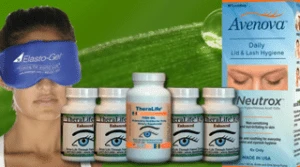Depression and chronic dry eyes
For years, doctors have noticed that many of their patients who are being treated for depression also suffer from chronic dry eyes. Several studies have shown that mental health diagnoses, such as post-traumatic stress disorder and depression, and their related treatments, have remained significantly linked with the increased risk of dry eye syndrome. The good news? There is a way to relieve dry eye symptoms naturally with TheraLife.
What the Studies Show
One study looked at nearly half a million patients. The study found that patients who suffered from chronic dry eye symptoms also suffered from anxiety or depression almost 3 times more than patients who did not have these issues.
Another study, reported by the National Center for Biotechnology Information, showed that there is a direct correlation between anxiety and depression. Eighty-nine (89%) subjects diagnosed with dry eye syndrome (DES) were studied.
After completing several different questionnaires pertaining to anxiety, depression, and ocular surface disease, the study found that patients with anxiety and depression had more dry eye symptoms than patients who did not suffer from anxiety and depression.
In fact, several studies have been published that show a connection between depression and dry eye disease.
This included a report published in Cornea that found a significant difference in dry eye symptoms for those who suffered from depression and those who did not. Another study published in March showed a statistically significant link between dry eye disease and those who have depression and anxiety.
The Reason for the Link
The common consensus for the link between dry eye syndrome and depression is the medication used to treat depression. Certain anti-depressants have been found to make the eye surface dry.
Medications with anticholinergic effects block acetylcholine in the brain. While effective in treating depression symptoms, these medications are known to be drying to the ocular surface.
Another link is how dry eye can exacerbate depression.
When a person has problems with daily life due to dry eye, the way someone participates in daily activities can lessen. This limitation in activity may lead to a decrease the quality of life, which can lead to social withdrawal and emotional strain.
Yet another important link is the stress hormones constrict blood vessels that supply blood and nutrients to the whole body, including the eyes. The stress hormones also fuel inflammation – root cause of many illnesses including chronic dry eyes.
Some eye care professionals have theories of the link between dry eyes and psychiatric medications used to treat depression.
They noticed that the medications used to treat depression can exacerbate dry eye disease.
In turn, the underlying mechanisms that cause depression, such as metabolic or hormonal imbalances, can also cause dry eye disease. The odds of patients who suffer from dry eyes are almost 3 times more likely to have depressive symptoms.
Dry Eye Symptoms
If you suffer from the typical dry eye symptoms, TheraLife can help calm and correct dry eye symptoms naturally. Some common dry eye symptoms include:
- Dryness
- Burning eyes
- Sandy-gritty eye irritation that worsens as the day progresses
- Itching
- Scratchy feeling
- Stinging
- Tired eyes
- Pain
- Redness
- Pulling sensation
- Pressure behind the eye
- Discomfort and sensitivity to bright light
How TheraLife Can Help
As a leader in chronic dry eye relief, the entire line of TheraLife products helps patients with dry eyes and depression find relief from the symptoms associated with dry eyes. TheraLife addresses the fundamental cause of dry eyes, underactive tear secretion, with their line of all-natural products.
- TheraLife Eye Enhanced – Clinically proven to provide relief in 80% of first-time users with chronic dry eye relief, TheraLife Eye Enhanced restores the eyes’ ability to produce tears naturally.
- TheraLife Eye Enhanced Starter Kit – Everything needed to provide dry eye relief, the starter kit contains 4 bottles of TheraLife Eye Enhanced, 1 bottle of Omega-3 Fish Oil, 1 EyeLid Cleanser, and 1 Hot Compress.

Stop depression caused by dry eyes. Get help now
Don’t suffer from dry eyes another day. Order your TheraLife starter kit and find relief naturally.
4.
Galea S, Ahern J, Resnick H, et al. Psychological sequelae of the September 11 terrorist attacks in New York City.
N Engl J Med. 2002;346(13):982-987. doi:
10.1056/NEJMsa0134045.
Silver RC, Holman EA, McIntosh DN, Poulin M, Gil-Rivas V. Nationwide longitudinal study of psychological responses to September 11.
JAMA. 2002;288(10):1235-1244. doi:
10.1001/jama.288.10.1235Article6.
Jalloh MF, Li W, Bunnell RE, et al. Impact of Ebola experiences and risk perceptions on mental health in Sierra Leone, July 2015.
BMJ Glob Health. 2018;3(2):e000471. doi:
10.1136/bmjgh-2017-0004717.
Hawryluck L, Gold WL, Robinson S, Pogorski S, Galea S, Styra R. SARS control and psychological effects of quarantine, Toronto, Canada.
Emerg Infect Dis. 2004;10(7):1206-1212. doi:
10.3201/eid1007.0307038.
Ni MY, Kim Y, McDowell I, et al. Mental health during and after protests, riots and revolutions: a systematic review.
Aust N Z J Psychiatry. 2020;54(3):232-243. doi:
10.1177/00048674198991659.
Ni MY, Yao XI, Leung KSM, et al. Depression and post-traumatic stress during major social unrest in Hong Kong: a 10-year prospective cohort study.
Lancet. 2020;395(10220):273-284. doi:
10.1016/S0140-6736(19)33160-510.
Ettman CK, Cohen GH, Galea S. Is wealth associated with depressive symptoms in the United States?
Ann Epidemiol. 2020;43:25-31.e1. doi:
10.1016/j.annepidem.2020.02.00111.
Karanikolos M, Mladovsky P, Cylus J, et al. Financial crisis, austerity, and health in Europe.
Lancet. 2013;381(9874):1323-1331. doi:
10.1016/S0140-6736(13)60102-612.
Frasquilho D, Matos MG, Salonna F, et al. Mental health outcomes in times of economic recession: a systematic literature review.
BMC Public Health. 2016;16:115. doi:
10.1186/s12889-016-2720-y13.
Tsai AC. Home foreclosure, health, and mental health: a systematic review of individual, aggregate, and contextual associations.
PLoS One. 2015;10(4):e0123182. doi:
10.1371/journal.pone.012318214.
Margerison-Zilko C, Goldman-Mellor S, Falconi A, Downing J. Health impacts of the Great Recession: a critical review.
Curr Epidemiol Rep. 2016;3(1):81-91. doi:
10.1007/s40471-016-0068-615.
Lai J, Ma S, Wang Y, et al. Factors associated with mental health outcomes among health care workers exposed to coronavirus disease 2019.
JAMA Netw Open. 2020;3(3):e203976-e203976. doi:
10.1001/jamanetworkopen.2020.3976Article16.
Cao W, Fang Z, Hou G, et al. The psychological impact of the COVID-19 epidemic on college students in China.
Psychiatry Res. 2020;287:112934. doi:
10.1016/j.psychres.2020.11293417.
Xiao H, Zhang Y, Kong D, Li S, Yang N. The effects of social support on sleep quality of medical staff treating patients with Coronavirus disease 2019 (COVID-19) in January and February 2020 in China.
Med Sci Monit. 2020;26:e923549-1-e923549-8. doi:
10.12659/MSM.92354918.
Nelson LM, Simard JF, Oluyomi A, et al. US public concerns about the COVID-19 pandemic from results of a survey given via social media.
JAMA Intern Med. 2020. doi:
10.1001/jamainternmed.2020.1369Article20.
Boardman JD, Finch BK, Ellison CG, Williams DR, Jackson JS. Neighborhood disadvantage, stress, and drug use among adults.
J Health Soc Behav. 2001;42(2):151-165. doi:
10.2307/3090175Pub21.
Galea S, Tracy M, Norris F, Coffey SF. Financial and social circumstances and the incidence and course of PTSD in Mississippi during the first two years after Hurricane Katrina.
J Trauma Stress. 2008;21(4):357-368. doi:
10.1002/jts.2035522.
Gao J, Zheng P, Jia Y, et al. Mental health problems and social media exposure during COVID-19 outbreak.
PLoS One. 2020;15(4):e0231924. doi:
10.1371/journal.pone.023192423.
Cronkite RC, Woodhead EL, Finlay A, Timko C, Unger Hu K, Moos RH. Life stressors and resources and the 23-year course of depression.
J Affect Disord. 2013;150(2):370-377. doi:
10.1016/j.jad.2013.04.02225.
McAllister A, Fritzell S, Almroth M, Harber-Aschan L, Larsson S, Burström B. How do macro-level structural determinants affect inequalities in mental health: a systematic review of the literature.
Int J Equity Health. 2018;17(1):180. doi:
10.1186/s12939-018-0879-927.
Dennis M, Dutwin D, Costanzo D. The undercounted: How NORC at the University of Chicago built the probability-based AmeriSpeak Panel to improve representativeness of America’s most difficult-to-reach populations. University of Maryland Joint Program in Survey Methodology seminar series. February 12, 2020. Accessed August 11, 2020.
https://psm.isr.umich.edu/sites/default/files/NORC%20AmeriSpeak.02.12.2020.pdf28.
Galea S, Merchant RM, Lurie N. The mental health consequences of COVID-19 and physical distancing: the need for prevention and early intervention.
JAMA Intern Med. 2020;180(6):817-818. doi:
10.1001/jamainternmed.2020.1562 





Adelaide or vancouver which place is better for dry eyes
Dhryma- Depends on which place has higher humidity. How about stay where you are and treat your dry eyes with TheraLife. Long sustainable dry eye relief treating from within. It works.